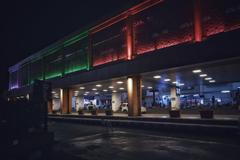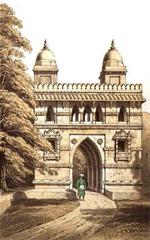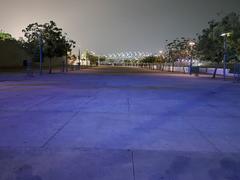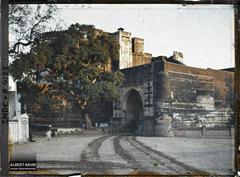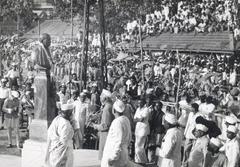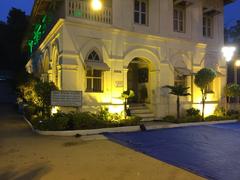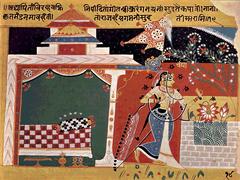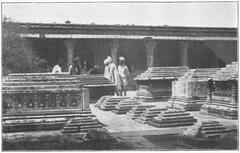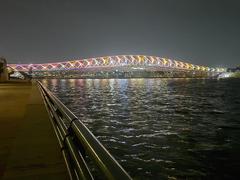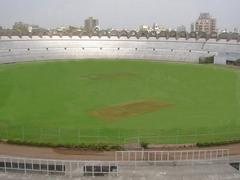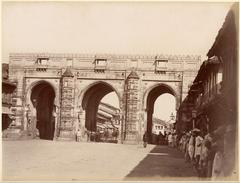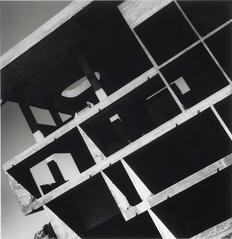दिल्ली दरवाजा अहमदाबाद: यात्रा का समय, टिकट और ऐतिहासिक स्थलों का मार्गदर्शक
तिथि: 03/07/2025
परिचय
दिल्ली दरवाजा, जिसे दिल्ली गेट या इदारियो दरवाजा के नाम से भी जाना जाता है, अहमदाबाद के सबसे प्रतिष्ठित और ऐतिहासिक रूप से महत्वपूर्ण प्रवेश द्वारों में से एक है। पुराने शहर की उत्तरी सीमा पर स्थित, यह 15वीं शताब्दी में इसके निर्माण के बाद से शहर के बचाव, व्यापार और सांस्कृतिक जीवन में एक प्रभावशाली इंडो-इस्लामिक वास्तुकला विरासत का प्रतीक है। मूल रूप से सुल्तान महमूद बेगड़ा के अधीन निर्मित, दिल्ली दरवाजा को शहर के मुख्य उत्तरी प्रवेश द्वार के रूप में डिजाइन किया गया था, जो अहमदाबाद को सीधे दिल्ली की ओर जाने वाली शाही सड़क से जोड़ता था। आज, यह हलचल भरे बाजारों से घिरा हुआ एक जीवंत शहरी स्थल बना हुआ है, और प्रमुख शहर उत्सवों और जुलूसों के लिए एक सभा बिंदु के रूप में कार्य करता है (यूनेस्को शहरी विरासत एटलस; अहमदाबाद की विरासत).
यह व्यापक मार्गदर्शिका दिल्ली दरवाजे की उत्पत्ति, वास्तुशिल्प विशेषताओं, सांस्कृतिक महत्व, व्यावहारिक यात्रा जानकारी—जिसमें घंटे, टिकट, पहुंच शामिल है—और इस आवश्यक अहमदाबाद ऐतिहासिक स्थल की अपनी यात्रा का अधिकतम लाभ उठाने के लिए सुझावों का विवरण देती है।
विषय सूची
- दिल्ली दरवाजे की उत्पत्ति और नींव
- वास्तुशिल्प विशेषताएं और निर्माण
- शहरी नियोजन और रक्षा में भूमिका
- सांस्कृतिक और सामाजिक महत्व
- दिल्ली दरवाजा का दौरा: घंटे, टिकट, पहुंच
- यात्रा सुझाव और स्थानीय अनुभव
- आस-पास के आकर्षण
- अक्सर पूछे जाने वाले प्रश्न (FAQ)
- संरक्षण और आधुनिक संदर्भ
- निष्कर्ष और यात्रा सारांश
- संबंधित लेख और संसाधन
- संदर्भ
दिल्ली दरवाजे की उत्पत्ति और नींव
दिल्ली दरवाजे की जड़ें गुजरात सल्तनत के दौरान अहमदाबाद के शुरुआती विस्तार से जुड़ी हैं। 1411 ईस्वी में सुल्तान अहमद शाह प्रथम द्वारा स्थापित, शहर मूल रूप से भद्रा किले और आठ द्वारों से सुरक्षित था। जैसे-जैसे शहर का विकास हुआ, नई किलेबंदी और द्वार जोड़े गए; दिल्ली दरवाजा सुल्तान महमूद बेगड़ा (शासनकाल 1458-1511), अहमद शाह के पोते के अधीन निर्मित किया गया था, जो शहर के उत्तरी प्रवेश द्वार के रूप में कार्य करता था (अहमदाबाद की विरासत; विकिपीडिया: अहमदाबाद के द्वार).
इसका वैकल्पिक नाम, इदारियो दरवाजा, इदार राज्य के खिलाफ महमूद बेगड़ा के अभियान का प्रतीक है। अपनी स्थापना के बाद से, दिल्ली दरवाजा शहर की रक्षा में एक महत्वपूर्ण कड़ी और उत्तरी भारत के लिए एक महत्वपूर्ण संबंध था, जो सैन्य रणनीति और शहरी नियोजन दोनों को दर्शाता है (अहमदाबाद शहर विरासत).
वास्तुशिल्प विशेषताएं और निर्माण
दिल्ली दरवाजा देर से मध्यकालीन इंडो-इस्लामिक सैन्य वास्तुकला का एक प्रमुख उदाहरण है। द्वार टिकाऊपन के लिए मजबूत एशलर चिनाई और चूना मोर्टार से बंधे ईंटों से बना है। इसकी सबसे विशिष्ट विशेषता तीन-मेहराबी मार्ग है: हाथियों और जुलूसों के लिए एक चौड़ा केंद्रीय मेहराब, पैदल चलने वालों और हल्के यातायात के लिए दो छोटे मेहराब (इस्लामी वास्तुकला विरासत; गुजरात पर्यटन).
अर्ध-वृत्ताकार बुर्जों से सटा हुआ और अलंकृत छज्जों से ढका हुआ, द्वार को रक्षा और भव्यता दोनों के लिए डिज़ाइन किया गया था। आंतरिक सीढ़ियाँ ऊपरी गार्ड कक्षों तक ले जाती हैं, और मूल लकड़ी के दरवाजों को हमलों—युद्ध हाथियों के हमलों सहित—का सामना करने के लिए लोहे के स्पाइक्स से मजबूत किया गया था। अलंकृत विवरणों में ज्यामितीय पैटर्न, पुष्प रूपांकन और पशु नक्काशी शामिल हैं, जो फारसी, मुगल और गुजराती डिजाइन तत्वों को मिश्रित करते हैं।
ब्रिटिश अधिकारियों ने 19वीं शताब्दी के अंत में द्वार को संशोधित किया, पैदल चलने वालों के लिए रास्ते जोड़े और शहरी यातायात के लिए परिवर्तन किए (अहमदाबाद शहर विरासत).
शहरी नियोजन और रक्षा में भूमिका
दिल्ली दरवाजा की स्थिति दिल्ली के शाही सड़क से सीधे जोड़ने वाले मुख्य उत्तरी द्वार के रूप में इसकी भूमिका को दर्शाती है। यह एक बड़ी रक्षात्मक प्रणाली का हिस्सा था, जिसमें 21 शहर द्वार प्रवेश, व्यापार और कराधान को नियंत्रित करते थे, और शहर के क्वार्टरों या “पुरा” (बाद में “पोल”) को अलग करते थे (अहमदाबाद की विरासत). द्वार सामानों और यात्रियों के लिए एक चेकपॉइंट के रूप में कार्य करता था, जो अहमदाबाद की वाणिज्यिक और रणनीतिक केंद्र के रूप में स्थिति को मजबूत करता था।
सांस्कृतिक और सामाजिक महत्व
दिल्ली दरवाजा अहमदाबाद में सामुदायिक जीवन का केंद्र बना हुआ है। विशेष रूप से दिवाली, उत्तरायण (पतंग उत्सव), और होली जैसे त्योहारों के दौरान आसपास के बाजार जीवंत होते हैं, जहाँ मौसमी सामान, वस्त्र, गहने और स्थानीय स्नैक्स बिकते हैं (अहमदाबाद शहर विरासत). यह क्षेत्र ऐतिहासिक व्यापारिक फर्मों का भी घर है और हुतीसिंग जैन मंदिर जैसे प्रमुख धार्मिक स्थलों के करीब है।
अहमदाबाद की सबसे बड़ी धार्मिक जुलूसों में से एक, वार्षिक जगन्नाथ रथ यात्रा के दौरान, हजारों भक्त और रथ दिल्ली दरवाजे से गुजरते हैं, जो इसके स्थायी नागरिक और आध्यात्मिक महत्व को रेखांकित करते हैं (बॉम्बे समाचार).
अहमदाबाद के बहुसांस्कृतिक लोकाचार को मस्जिदों, मंदिरों और हलचल भरे बाजारों की निकटता में दर्शाया गया है, जिससे दिल्ली दरवाजा शहर की सहिष्णुता और लचीलेपन का प्रतीक बन गया है (रफ गाइड).
दिल्ली दरवाजा का दौरा: घंटे, टिकट, पहुंच
- यात्रा का समय: दिल्ली दरवाजा एक सार्वजनिक शहर द्वार के रूप में 24/7 खुला है। सर्वोत्तम अनुभव और सुरक्षा के लिए, सुबह 8:00 बजे से शाम 7:00 बजे के बीच जाएँ।
- प्रवेश शुल्क: कोई प्रवेश शुल्क नहीं है; स्मारक का दौरा करना निःशुल्क है।
- पहुंच: क्षेत्र पैदल चलने वालों के अनुकूल है लेकिन भीड़भाड़ वाला हो सकता है और फुटपाथ असमान हो सकते हैं। व्हीलचेयर पहुंच सीमित है; विशेष आवश्यकता वाले आगंतुकों के लिए सहायता की सिफारिश की जाती है।
- फोटोग्राफी: फोटोग्राफी की अनुमति है; लोगों की, विशेषकर बाजारों में या त्योहारों के दौरान, तस्वीरें लेने से पहले पूछें।
- सुविधाएं: सार्वजनिक शौचालय दुर्लभ हैं; 1 किमी के भीतर एटीएम और बैंक उपलब्ध हैं। मोबाइल नेटवर्क कवरेज मजबूत है।
यात्रा सुझाव और स्थानीय अनुभव
- वहाँ कैसे पहुँचें: दिल्ली दरवाजा दिल्ली चकला के पास स्थित है, जो अहमदाबाद रेलवे स्टेशन से लगभग 4 किमी और हवाई अड्डे से 10 किमी दूर है। ऑटो-रिक्शा, टैक्सी और शहर की बसें सबसे सुविधाजनक परिवहन हैं।
- यात्रा का सबसे अच्छा समय: नवंबर से फरवरी सुखद मौसम प्रदान करता है। चरम गर्मी (अप्रैल-जून) से बचें और मानसून (जुलाई-सितंबर) और त्योहारों के दौरान भीड़ की उम्मीद करें।
- पोशाक संहिता: मामूली कपड़ों की सिफारिश की जाती है, खासकर धार्मिक स्थलों के पास।
- खरीदारी और भोजन: यह क्षेत्र अपने बाजारों के लिए प्रसिद्ध है—वस्त्र, गहने और स्थानीय हस्तशिल्प खरीदें। मणिक चौक और आसपास के स्टालों पर स्ट्रीट फूड आज़माएँ।
- सुरक्षा: अहमदाबाद आम तौर पर सुरक्षित है, लेकिन व्यस्त बाजारों में सतर्क रहें। मानसून के दौरान पानी ले जाएँ और यात्रा बीमा का उपयोग करें, और मच्छर से बचाव करें।
आस-पास के आकर्षण
- भद्रा किला: दिल्ली दरवाजे से थोड़ी पैदल दूरी पर ऐतिहासिक किला और महल परिसर।
- मणिक चौक: पास में प्रसिद्ध बाजार और रात का भोजन स्थल।
- हुतीसिंग जैन मंदिर: पैदल दूरी के भीतर, अपनी सुंदर वास्तुकला के लिए उल्लेखनीय।
- जामा मस्जिद: भारत की सबसे महत्वपूर्ण मस्जिदों में से एक, यह भी पास में है।
अहमदाबाद की विरासत की गहरी समझ के लिए इन स्थलों का अन्वेषण करें (गुजरात पर्यटन; रफ गाइड).
अक्सर पूछे जाने वाले प्रश्न (FAQ)
प्रश्न: दिल्ली दरवाजे के लिए यात्रा का समय क्या है? A: 24/7 खुला है, लेकिन सुबह 8:00 बजे से शाम 7:00 बजे के बीच जाना सबसे अच्छा है।
प्रश्न: क्या कोई प्रवेश शुल्क या टिकट आवश्यक है? A: नहीं, प्रवेश निःशुल्क है।
प्रश्न: क्या निर्देशित दौरे उपलब्ध हैं? A: हाँ, कई स्थानीय ऑपरेटर दिल्ली दरवाजे सहित हेरिटेज वॉक प्रदान करते हैं।
प्रश्न: क्या साइट व्हीलचेयर सुलभ है? A: ऐतिहासिक फुटपाथों और भीड़ के कारण पहुंच सीमित है; सहायता की सिफारिश की जाती है।
प्रश्न: दिल्ली दरवाजे तक पहुँचने का सबसे अच्छा तरीका क्या है? A: मध्य अहमदाबाद से ऑटो-रिक्शा, टैक्सी या सार्वजनिक बस द्वारा आसानी से पहुँचा जा सकता है।
प्रश्न: क्या सार्वजनिक शौचालय हैं? A: सीमित; आस-पास के रेस्तरां या शॉपिंग कॉम्प्लेक्स में सुविधाओं का उपयोग करें।
संरक्षण और आधुनिक संदर्भ
अहमदाबाद की शहर की दीवारों के बड़े हिस्से के विध्वंस के बावजूद, दिल्ली दरवाजा एक संरक्षित स्मारक के रूप में बना हुआ है। भारतीय पुरातत्व सर्वेक्षण और स्थानीय विरासत समूहों के संरक्षण प्रयासों ने आधुनिक, हलचल भरे शहर की जरूरतों को पूरा करते हुए इसकी संरचना और सजावटी सुविधाओं को संरक्षित करने पर ध्यान केंद्रित किया है (अहमदाबाद शहर विरासत; अहमदाबाद की विरासत).
निष्कर्ष और यात्रा सारांश
दिल्ली दरवाजा न केवल अहमदाबाद के पुराने शहर में एक प्रवेश द्वार है, बल्कि इसके जटिल इतिहास, वास्तुशिल्प भव्यता और जीवंत सामुदायिक जीवन का प्रवेश द्वार भी है। यह लचीलेपन और अनुकूलन क्षमता का प्रतीक है—जहाँ मध्ययुगीन परंपराएँ और समकालीन शहरी लय सहज रूप से सह-अस्तित्व में हैं। खुले पहुँच, कोई प्रवेश शुल्क नहीं, और अन्य प्रमुख स्थलों से निकटता के साथ, दिल्ली दरवाजा अहमदाबाद के इतिहास के प्रति उत्साही, संस्कृति के चाहने वालों और प्रामाणिक अनुभव की तलाश करने वाले यात्रियों के लिए अवश्य देखने योग्य है।
ठंडे महीनों के दौरान अपनी यात्रा की योजना बनाएँ, निर्देशित पैदल यात्रा का लाभ उठाएँ, और अहमदाबाद के अतीत और वर्तमान की एक सच्ची विसर्जन यात्रा के लिए हलचल भरे बाजारों का अन्वेषण करें।
संबंधित लेख और संसाधन
संदर्भ
- यूनेस्को शहरी विरासत एटलस
- अहमदाबाद की विरासत
- विकिपीडिया: अहमदाबाद के द्वार
- अहमदाबाद शहर विरासत
- इस्लामी वास्तुकला विरासत
- गुजरात पर्यटन
- नॉक्ससेंस
- बॉम्बे समाचार
- रफ गाइड
- ट्रैवलिंग कैमरा
ऑडियाला2024{‘date’: ‘03/07/2025’, ‘task’: {‘model’: ‘gpt-4.1-mini’, ‘query’: ‘Comprehensive guide to visiting Delhi Darwaja, Ahmedabad, India: history, significance, visitor tips, and everything tourists need to know for a memorable experience.’, ‘verbose’: False, ‘guidelines’: [“Keyword Research: Identify relevant keywords that potential visitors are likely to search for, such as ‘[Monument Name] visiting hours,’ ‘[Monument Name] tickets,’ and ‘[City] historical sites.’ Use these keywords strategically throughout the article, including in the title, headers, and body text, but avoid keyword stuffing.”, ‘Engaging and Informative Title: Craft a title that is both SEO-friendly and compelling to encourage clicks. Include the main keyword and make it clear what the article will cover.’, ‘Structured Content: Use headings (H1, H2, H3) to organize the content effectively. This helps with SEO and makes the article easier for readers to navigate. Include an introduction that hooks the reader, a detailed body that covers all relevant aspects, and a conclusion that summarizes the key points.’, ‘Comprehensive Coverage: Address common questions and topics of interest such as the history of the monument, its cultural significance, visitor information (e.g., ticket prices, opening hours), travel tips, nearby attractions, and accessibility. Include sections that might be unique to the monument, like special events, guided tours, and photographic spots.’, ‘Quality Content: Ensure the content is well-researched, accurate, and provides real value to readers. Use reliable sources and provide factual information. Write in a clear, engaging, and accessible style. Consider your audience and use language that is appropriate for those likely to visit the monument.’, ‘Visuals and Media: Incorporate high-quality images or videos of the monument. These should be optimized for the web (correct sizing, alt tags with keywords). Consider interactive elements like virtual tours or maps.’, ‘Internal and External Links: Include links to other related articles on your site to encourage deeper engagement (internal links). Link to official websites for the monument or credible sources for further reading (external links).’, ‘FAQ: Incorporate FAQ sections to target voice search queries and featured snippets’, ‘Visit and Stay Up to Date: End the article with a call to action, such as encouraging readers to download our mobile app Audiala, check out other related posts, or follow on social media for more updates.’], ‘max_sections’: 4, ‘publish_formats’: {‘pdf’: False, ‘docx’: False, ‘markdown’: True}, ‘follow_guidelines’: True}, ‘title’: ‘A Comprehensive Guide to Visiting Delhi Darwaja, Ahmedabad, India’, ‘report’: ’# Delhi Darwaja Ahmedabad: Visiting Hours, Tickets, and Historical Sites Guide\n\n#### Date: 03/07/2025\n\n---\n\n## Introduction\n\nDelhi Darwaja—also known as Delhi Gate or Idariyo Darwajo—is one of Ahmedabad’s most iconic and historically significant gateways. Standing on the northern edge of the old walled city, it embodies an impressive Indo-Islamic architectural legacy and has played a central role in the city’s defense, trade, and cultural life since its construction in the 15th century. Initially built under Sultan Mahmud Begada, Delhi Darwaja was conceived as the city’s main northern entrance, directly linking Ahmedabad to the imperial road leading to Delhi. Today, it remains a bustling urban landmark, surrounded by vibrant markets and serving as a gathering point for major city festivals and processions (UNESCO Urban Heritage Atlas; Heritage of Ahmedabad).\n\nThis comprehensive guide details Delhi Darwaja’s origins, architectural features, cultural importance, practical visiting information—including hours, tickets, accessibility—and tips for making the most of your visit to this essential Ahmedabad historical site.\n\n---\n\n## Table of Contents\n\n- Origins and Foundation of Delhi Darwaja\n- Architectural Features and Construction\n- Role in Urban Planning and Defense\n- Cultural and Social Significance\n- Visiting Delhi Darwaja: Hours, Tickets, Accessibility\n- Travel Tips and Local Experiences\n- Nearby Attractions\n- Frequently Asked Questions (FAQ)\n- Preservation and Modern Context\n- Conclusion and Visit Summary\n- Related Articles and Resources\n- References\n\n---\n\n## Origins and Foundation of Delhi Darwaja\n\nDelhi Darwaja’s roots trace back to the early expansion of Ahmedabad during the Gujarat Sultanate. Founded in 1411 CE by Sultan Ahmed Shah I, the city was originally protected by Bhadra Fort and eight gates. As the city grew, new fortifications and gates were added; Delhi Darwaja was constructed under Sultan Mahmud Begada (ruled 1458–1511), Ahmed Shah’s grandson, to serve as the fortified northern entrance (Heritage of Ahmedabad; Wikipedia: Gates of Ahmedabad).\n\nIts alternate name, Idariyo Darwajo, commemorates Mahmud Begada’s campaign against the Idar State. From its inception, Delhi Darwaja was a key node in the city’s defense and a critical link to northern India, reflecting both military strategy and urban planning (Ahmedabad City Heritage).\n\n---\n\n## Architectural Features and Construction\n\nDelhi Darwaja is a prime example of late medieval Indo-Islamic military architecture. The gateway is built of robust ashlar masonry and brick, bound with lime mortar for durability. Its most distinctive feature is the triple-arched passage: a wide central arch for elephants and processions, with two smaller side arches for pedestrian and lighter traffic (Islamic Architectural Heritage; Gujarat Tourism).\n\nFlanked by semi-circular bastions and capped with crenellated parapets, the gate was designed for both defense and grandeur. Internal staircases lead to upper guard chambers, and the original wooden doors were reinforced with iron spikes to withstand attacks—including those by war elephants. Ornamental details include geometric patterns, floral motifs, and animal carvings, blending Persian, Mughal, and Gujarati design elements.\n\nBritish authorities modified the gate in the late 19th century, adding pedestrian openings and making alterations for urban traffic (Ahmedabad City Heritage).\n\n---\n\n## Role in Urban Planning and Defense\n\nDelhi Darwaja’s position reflected its role as the main northern gateway, directly connecting Ahmedabad with Delhi’s imperial road. It formed part of a larger defensive network, with up to 21 city gates regulating entry, trade, and taxation, and separating city quarters or “puras” (later “pols”) (Heritage of Ahmedabad). The gate served as a checkpoint for goods and travelers, reinforcing Ahmedabad’s status as a commercial and strategic hub.\n\n---\n\n## Cultural and Social Significance\n\nDelhi Darwaja remains an epicenter of community life in Ahmedabad. The surrounding markets are especially vibrant during festivals like Diwali, Uttrayan (kite festival), and Holi, with stalls selling seasonal goods, textiles, jewelry, and local snacks (Ahmedabad City Heritage). The area is also home to historic trading firms and is close to major religious landmarks such as the Hutheesing Jain Temple.\n\nDuring the annual Jagannath Rath Yatra, one of Ahmedabad’s largest religious processions, thousands of devotees and chariots pass through Delhi Darwaja, highlighting its enduring civic and spiritual significance (Bombay Samachar).\n\nAhmedabad’s multicultural ethos is reflected in the proximity of mosques, temples, and vibrant markets, making Delhi Darwaja a symbol of the city’s pluralism and resilience (Rough Guides).\n\n---\n\n## Visiting Delhi Darwaja: Hours, Tickets, Accessibility\n\n- Visiting Hours: Delhi Darwaja is open 24/7 as a public city gate. For the best experience and safety, visit between 8:00 AM and 7:00 PM.\n- Entry Fee: There is no entry fee; the monument is free to visit.\n- Accessibility: The area is pedestrian-friendly but can be crowded and has uneven pavements. Wheelchair access is limited; assistance is recommended for differently-abled visitors.\n- Photography: Photography is permitted; ask before photographing people, especially in markets or during festivals.\n- Facilities: Public restrooms are scarce; ATMs and banks are available within 1 km. Mobile network coverage is strong.\n\n---\n\n## Travel Tips and Local Experiences\n\n- Getting There: Delhi Darwaja is located near Delhi Chakla, about 4 km from Ahmedabad Railway Station and 10 km from the airport. Auto-rickshaws, taxis, and city buses are the most convenient transportation.\n- Best Time to Visit: November to February offers pleasant weather. Avoid peak heat (April–June) and expect crowds during monsoon (July–September) and festivals.\n- Dress Code: Modest clothing is recommended, especially near religious sites.\n- Shopping & Food: The area is renowned for its bazaars—shop for textiles, jewelry, and local handicrafts. Try street food at Manek Chowk and nearby stalls.\n- Safety: Ahmedabad is generally safe, but remain vigilant in busy markets. Carry water and travel insurance, and use mosquito protection during monsoon.\n\n---\n\n## Nearby Attractions\n\n- Bhadra Fort: Historic fort and palace complex, a short walk from Delhi Darwaja.\n- Manek Chowk: Famous market and night food street nearby.\n- Hutheesing Jain Temple: Noted for its beautiful architecture, within walking distance.\n- Jama Masjid: One of India’s most significant mosques, also close by.\n\nExplore these sites for a deeper understanding of Ahmedabad’s heritage (Gujarat Tourism; Rough Guides).\n\n---\n\n## Frequently Asked Questions (FAQ)\n\nQ: What are the visiting hours for Delhi Darwaja? \nA: Open 24/7, but best visited between 8:00 AM and 7:00 PM.\n\nQ: Is there an entry fee or ticket required? \nA: No, entry is free.\n\nQ: Are guided tours available? \nA: Yes, several local operators offer heritage walks including Delhi Darwaja.\n\nQ: Is the site wheelchair accessible? \nA: Accessibility is limited due to historic pavements and crowds; assistance is recommended.\n\nQ: What is the best way to reach Delhi Darwaja? \nA: Easily reached by auto-rickshaw, taxi, or public bus from central Ahmedabad.\n\nQ: Are there public restrooms? \nA: Limited; use facilities at nearby restaurants or shopping complexes.\n\n---\n\n## Preservation and Modern Context\n\nDespite the demolition of much of Ahmedabad’s city walls, Delhi Darwaja has been preserved as a protected monument. Restoration efforts by the Archaeological Survey of India and local heritage groups have focused on conserving its structure and decorative features while accommodating the needs of a modern, bustling city (Ahmedabad City Heritage; Heritage of Ahmedabad).\n\n---\n\n## Conclusion and Visit Summary\n\nDelhi Darwaja is not only a gateway into Ahmedabad’s walled city but also an entrance to its complex history, architectural splendor, and vibrant community life. It stands as a symbol of resilience and adaptability—where medieval traditions and contemporary urban rhythms seamlessly coexist. With open access, no entry fees, and proximity to other major landmarks, Delhi Darwaja is a must-visit for history enthusiasts, culture seekers, and travelers seeking an authentic Ahmedabad experience.\n\nPlan your visit during the cooler months, take advantage of guided walks, and explore the bustling bazaars for a truly immersive journey into Ahmedabad’s past and present.\n\n---\n\n## Related Articles and Resources\n\n- Exploring Bhadra Fort: Ahmedabad’s Historic Citadel\n- Top Heritage Pols to Visit in Ahmedabad\n- The Festive Spirit of Ahmedabad: A Guide to Major Festivals\n\nStay updated with the latest heritage tours and events—download the Audiala app for guided tours, maps, and local insights. Follow us on Facebook, Instagram, and Twitter.\n\n---\n\n## References\n\n- UNESCO Urban Heritage Atlas\n- Heritage of Ahmedabad\n- Wikipedia: Gates of Ahmedabad\n- Ahmedabad City Heritage\n- Islamic Architectural Heritage\n- Gujarat Tourism\n- Knocksense\n- Bombay Samachar\n- Rough Guides\n- Travelling Camera\n\n---\n\n’, ‘headers’: {‘date’: ‘Date’, ‘title’: ‘Delhi Darwaja Ahmedabad Visiting Hours Tickets and Historical Sites Guide’, ‘conclusion’: ‘Summary and Visit Tips for Delhi Darwaja Ahmedabad’, ‘references’: ‘References and Further Reading’, ‘introduction’: ‘Introduction to Delhi Darwaja Ahmedabad’, ‘table_of_contents’: ‘Table of Contents’}, ‘sources’: [’- UNESCO Urban Heritage Atlas, n.d., UNESCO https://whc.unesco.org/en/urban-heritage-atlas/ahmedabad/’, ’- Heritage of Ahmedabad, n.d., Heritage of Ahmedabad https://heritageofahmedabad.com/delhi-darwaja/’, ’- Wikipedia: Gates of Ahmedabad, n.d. https://en.wikipedia.org/wiki/Gates_of_Ahmedabad’, ’- Ahmedabad City Heritage, n.d. http://heritage.ahmedabadcity.gov.in/details/86/heritage_site/all_heritages/en’, ’- Islamic Architectural Heritage, n.d. https://www.islamicarchitecturalheritage.com/listings/delhi-darwaja’, ’- Gujarat Tourism, n.d., Gujarat Tourism https://www.gujarattourism.com/central-zone/ahmedabad/delhi-gate.html’, ’- Knocksense, n.d. https://www.knocksense.com/ahmedabad/ahmedabads-iconic-gateway-delhi-darwaza-and-its-ever-changing-face’, ’- Bombay Samachar, 2025, Ahmedabad Jagannath Rath Yatra Complete Guide https://english.bombaysamachar.com/gujarat/ahmedabad-jagannath-rath-yatra-2025-complete-guide-to-date-historic-route-live-darshan/’, ’- Rough Guides, n.d., Ahmedabad Travel Guide https://www.roughguides.com/india/gujarat/ahmedabad/’, ’- Travelling Camera, 2022, Teen Darwazah Ahmedabad [https://www.travellingcamera.com/2022/09/teen-darwazah-ahmedabad-gujrat.html)’], ‘sections’: [‘Historical Background’, ‘Architectural Features’, ‘Cultural and Social Significance’, ‘Visiting Delhi Darwaja: Practical Information’], ‘conclusion’: ‘Delhi Darwaja remains a compelling symbol of Ahmedabad’s historical depth, architectural ingenuity, and vibrant cultural mosaic. From its origins as a fortified gateway built under Sultan Mahmud Begada’s leadership to its role in facilitating trade, defense, and community rituals, the gate embodies the city’s evolving identity through centuries of political change and urban development. Its enduring presence amidst the bustling markets and religious festivities of Ahmedabad’s old city highlights the seamless integration of heritage and living culture, making it an essential destination for travelers seeking an authentic and immersive experience (Heritage of Ahmedabad; Ahmedabad City Heritage).\n\nVisitors benefit from the site’s open access, with no entry fees and availability throughout the year, allowing for flexible planning around the best visiting hours and local festival calendars. The gate’s architectural features, including its triple arches, bastions, and ornate carvings, offer rich insights into medieval Indo-Islamic military and artistic traditions. Moreover, Delhi Darwaja’s close proximity to other prominent historical sites such as Bhadra Fort, Hutheesing Jain Temple, and Teen Darwaza enables a comprehensive exploration of Ahmedabad’s heritage precincts (Gujarat Tourism; Rough Guides).\n\nBy visiting Delhi Darwaja, travelers not only witness a remarkable architectural monument but also engage with the living traditions and social rhythms of Ahmedabad’s old city. To enhance your visit, consider joining guided heritage walks, exploring nearby markets and festivals, and using resources like the Audiala app for maps and local insights. Stay connected through social media and related heritage content to keep abreast of events and tours. Delhi Darwaja offers a profound journey into the heart of Ahmedabad’s past and present—inviting all to discover the stories etched in stone and the vibrant life that continues to surround this historic gateway (Knocksense; Bombay Samachar).’, ‘introduction’: ‘Delhi Darwaja, also known as Delhi Gate or Idariyo Darwajo, stands as one of Ahmedabad’s most iconic and historically significant gateways. Situated on the northern edge of Ahmedabad’s old walled city, this majestic structure reflects the city’s rich Indo-Islamic architectural heritage and has served as a pivotal point of urban defense, trade, and cultural exchange since its construction in the 15th century. Originally built during the reign of Sultan Mahmud Begada, Delhi Darwaja was strategically positioned as the main northern entrance, connecting Ahmedabad to the imperial capital of Delhi, which underlines the gate’s importance in medieval urban planning and military strategy (UNESCO Urban Heritage Atlas; Heritage of Ahmedabad).\n\nThe architectural grandeur of Delhi Darwaja is characterized by robust ashlar stone masonry, triple-arched gateways designed to accommodate both pedestrians and elephants, and decorative carvings that embody the syncretic Indo-Islamic style with Persian, Mughal, and local Gujarati influences (Islamic Architectural Heritage; Gujarat Tourism). Beyond its military and architectural significance, the gate remains a vibrant cultural hub surrounded by bustling markets, religious sites, and venues for festivals such as the Jagannath Rath Yatra and Uttrayan kite festival, which celebrate Ahmedabad’s pluralistic heritage and community life (Bombay Samachar; Rough Guides).\n\nToday, Delhi Darwaja is freely accessible to visitors throughout the year, offering a gateway not only into the historic fabric of Ahmedabad but also into its thriving contemporary social and commercial life. This comprehensive guide explores Delhi Darwaja’s historical origins, architectural details, cultural relevance, and provides essential visitor information including visiting hours, ticket policies, accessibility, and travel tips to enrich your experience of one of Ahmedabad’s most treasured landmarks (Ahmedabad City Heritage; Knocksense).’, ‘research_data’: [{‘draft title’: ’# Delhi Darwaja: Exploring Ahmedabad’s Historic Gateway and Must-Visit Historical Site\n\n## Introduction\n\nDelhi Darwaja, also known as Delhi Gate or Idariyo Darwajo, is one of Ahmedabad’s most iconic historical sites and a key landmark in the old walled city of Ahmedabad, Gujarat, India. This article covers the rich history, architectural marvels, cultural significance, and practical visitor information about Delhi Darwaja, making it an essential guide for travelers and history enthusiasts alike. Whether you are searching for “Delhi Darwaja visiting hours,” “Delhi Darwaja tickets,” or other details about Ahmedabad historical sites, this comprehensive guide will help you plan your visit.\n\n## Origins and Foundation of Delhi Darwaja\n\nDelhi Darwaja’s origins are closely linked to the founding and expansion of Ahmedabad itself. Established in 1411 CE by Sultan Ahmed Shah I of the Gujarat Sultanate, Ahmedabad was designed as a fortified city east of the ancient settlement of Ashaval (UNESCO Urban Heritage Atlas; Heritage of Ahmedabad). Initially, the city was fortified by Bhadra Fort with eight gates. As Ahmedabad expanded, a larger fortification wall was built, incorporating additional gates, including the Delhi Darwaja (Wikipedia: Gates of Ahmedabad).\n\nThe construction of Delhi Darwaja is attributed to Sultan Mahmud Begada (ruled 1458–1511), grandson of Ahmed Shah I. Known for military campaigns and reinforcing city defenses, Mahmud Begada’s campaign against Idar State inspired the gate’s alternative name, Idariyo Darwajo. Strategically located on the northern side facing Delhi, the gate served as a critical access point (Ahmedabad City Heritage).\n\n## Architectural Features and Construction\n\nDelhi Darwaja exemplifies Bahmanid architectural style with sturdy ashlar stone masonry and defensive elements. It features three stone arches about 15 feet wide and 22 feet high, supporting a roofed platform measuring 32 by 20 feet, originally pierced for one gun, reflecting its military function (Islamic Architectural Heritage; Ahmedabad City Heritage). The original iron-plated timber doors enhanced the gate’s security.\n\nIn 1878, the British colonial administration added two pedestrian openings on either side of the main gate to accommodate increased traffic, each 8 feet wide and 16 feet high, at a cost equivalent to over INR 3.3 million today (Ahmedabad City Heritage). Decorative carvings of elephants and lions adorn the windows, showcasing period artistry. The use of ashlar masonry, lime plaster, and terracotta bricks highlights Sultanate-era construction techniques.\n\n## Role in Urban Planning and Defense\n\nDelhi Darwaja was vital to Ahmedabad’s urban planning and defense. Serving as the northern gateway, it was the main entry for travelers and traders from Delhi, the imperial capital. Part of a system of up to 21 historic gates, the structure also functioned as a checkpoint for tax collection and goods regulation, while demarcating neighborhoods, or puras, which later evolved into pols—traditional residential clusters (Heritage of Ahmedabad; AHT2020 Tanvi).\n\n## Historical Events and Associations\n\nDelhi Darwaja has witnessed significant historical events, from Sultanate military campaigns to colonial-era modifications. Its alternate name, Idariyo Darwajo, commemorates Mahmud Begada’s conquest of Idar State (Ahmedabad City Heritage). British colonial authorities altered the gate in the late 19th century to accommodate urban growth and the railway’s arrival (Wikipedia: Gates of Ahmedabad). The terrace roof was removed in 1877 during repairs (Islamic Architectural Heritage).\n\nThe gate also symbolizes civic pride; in 1831, local residents funded wall repairs through voluntary taxes on ghee, reflecting community-driven governance (Ahmedabad City Heritage).\n\n## Cultural and Social Significance\n\nDelhi Darwaja remains central to Ahmedabad’s cultural life. The surrounding area bustles with markets, especially during festivals like Diwali, Uttrayan (kite festival), and Holi, offering seasonal goods (Ahmedabad City Heritage). Historic pedhis (trading firms) nearby trade in commodities such as ghee and jaggery.\n\nNearby landmarks include the Hutheesing Jain Temple (1848), adding religious and cultural depth. The vicinity showcases Ahmedabad’s multicultural heritage with institutions from multiple faiths coexisting peacefully (UNESCO Urban Heritage Atlas).\n\n## Visiting Delhi Darwaja: Practical Information\n\nVisiting Hours: Delhi Darwaja is accessible to visitors 24 hours a day, but daytime visits are recommended to appreciate its architectural details and the lively market atmosphere.\n\nTickets: There is no entry fee to visit Delhi Darwaja, making it an affordable and convenient destination.\n\nAccessibility: The gate and surrounding market area are pedestrian-friendly, though the busy market streets can be crowded. Visitors with mobility impairments should plan accordingly.\n\nTravel Tips:\n- Visit early in the morning or late afternoon to avoid peak crowding.\n- Explore nearby attractions such as Bhadra Fort, Hutheesing Jain Temple, and the Pols of Ahmedabad.\n- Carry water and wear comfortable footwear for walking through the bustling markets.\n\nGuided Tours and Events: Many local tour operators include Delhi Darwaja in heritage walks that explore Ahmedabad’s old city. Seasonal festivals like Uttrayan provide vibrant photographic opportunities around the gate.\n\n## Frequently Asked Questions (FAQ)\n\nQ1: What are the visiting hours for Delhi Darwaja? \nA1: Delhi Darwaja is open to visitors 24/7, but it is best visited during daylight hours.\n\nQ2: Is there an entry fee or ticket required to visit Delhi Darwaja? \nA2: No, visiting Delhi Darwaja is free of charge.\n\nQ3: How do I reach Delhi Darwaja? \nA3: Delhi Darwaja is located in the old city of Ahmedabad and is accessible by auto-rickshaw, taxi, or on foot from central Ahmedabad.\n\nQ4: Are guided tours available? \nA4: Yes, several local tour operators offer heritage walks that include Delhi Darwaja.\n\nQ5: What other historical sites are nearby? \nA5: Nearby attractions include Bhadra Fort, Hutheesing Jain Temple, and the various pols (traditional neighborhoods) of Ahmedabad.\n\n## Preservation and Modern Context\n\nDespite modernization and the demolition of much of Ahmedabad’s fort walls, Delhi Darwaja endures as a testament to the city’s layered history. The gate remains a vibrant part of the old city’s fabric, marking the historic northern boundary and linking present-day Ahmedabad to its Sultanate past (Ahmedabad City Heritage).\n\n## Conclusion\n\nDelhi Darwaja stands as a remarkable gateway into Ahmedabad’s rich history, culture, and architecture. From its strategic origins in the 15th century to its role as a bustling marketplace and cultural hub today, the gate invites visitors to explore the vibrant heritage of one of India’s most fascinating cities. Whether you are a history buff, a cultural explorer, or a casual tourist, Delhi Darwaja offers an immersive experience into Ahmedabad’s past and present.\n\nPlan your visit today and discover the stories etched in stone at this must-see historical site.\n\n---\n\nRelated Articles:\n- Exploring Bhadra Fort: Ahmedabad’s Historic Citadel\n- Top Heritage Pols to Visit in Ahmedabad\n- The Festive Spirit of Ahmedabad: A Guide to Major Festivals\n\nFollow Us:\nStay updated with the latest heritage tours and events. Follow us on Facebook, Instagram, and Twitter.\n\nDownload the Audiala App:\nEnhance your Ahmedabad heritage exploration with the Audiala app, featuring guided tours, maps, and local insights. Available on Google Play and the App Store.\n\n\n\n \nAlt text: Front view of Delhi Darwaja gate bathed in daylight showcasing its stone arches and carvings.\n\n
\nAlt text: Front view of Delhi Darwaja gate bathed in daylight showcasing its stone arches and carvings.\n\n \nAlt text: Busy street market near Delhi Darwaja during a festival.’}, {‘draft title’: ’# Exploring Delhi Darwaja: A Comprehensive Guide to Ahmedabad Historical Site\n\n## Historical Context and Urban Placement\n\nDelhi Darwaja, one of the principal gateways of the old walled city of Ahmedabad, stands as a testament to the city’s medieval urban planning and architectural ingenuity. Constructed in the early 15th century during the reign of Sultan Ahmed Shah I, the founder of Ahmedabad, the gate was strategically positioned on the northern periphery of the city’s original fortifications. Its placement was not arbitrary; it served as the main northern entrance, connecting Ahmedabad to the road leading towards Delhi, hence its name. The gate’s orientation and alignment reflect the city’s historical trade routes and military considerations, ensuring both accessibility and defensibility (Gujarat Tourism).\n\n## Structural Composition and Materials\n\nDelhi Darwaja exemplifies the robust construction techniques of Indo-Islamic military architecture. The gateway is primarily built from locally sourced sandstone and brick, materials chosen for their durability and availability in the region. The use of lime mortar as a binding agent was standard practice, contributing to the structure’s longevity. The gate’s walls are notably thick—often exceeding 1.5 meters—designed to withstand both the elements and potential sieges. The original wooden doors, reinforced with iron spikes, were intended to deter attacks by war elephants, a common siege tactic in medieval India.\n\n## Architectural Layout and Defensive Features\n\n### Triple-Arched Passage\n\nA defining feature of Delhi Darwaja is its triple-arched passage. The central arch, significantly larger than the flanking side arches, was designed to accommodate the passage of elephants, cavalry, and large processions. The side arches allowed for pedestrian and smaller vehicular movement, facilitating efficient traffic flow while maintaining security. The arches are pointed, a hallmark of Islamic architecture, and are framed by decorative bands of stonework.\n\n### Bastions and Flanking Towers\n\nThe gateway is flanked by semi-circular bastions on either side, rising above the main structure. These bastions served both as defensive platforms and as vantage points for guards. The upper levels feature crenellated parapets—merlons and embrasures—allowing defenders to observe and repel attackers while remaining protected. Arrow slits and small windows are integrated into the bastions, providing additional defensive capabilities without compromising the structural integrity.\n\n### Guard Chambers and Internal Stairways\n\nWithin the thickness of the gate’s walls are concealed chambers and stairways. These spaces were used by guards for surveillance and as resting quarters during their watch. The stairways lead to the upper levels of the bastions, enabling quick movement between different defensive positions. The presence of these internal features highlights the dual function of the gate as both a ceremonial entrance and a military outpost.\n\n## Decorative Elements and Symbolism\n\n### Carvings and Inscriptions\n\nWhile Delhi Darwaja’s primary function was defensive, it also features ornamental elements that reflect the artistic sensibilities of the period. The spandrels of the arches are adorned with geometric patterns and floral motifs, executed in low relief. These designs are characteristic of the Indo-Islamic style, blending Persian influences with local Gujarati craftsmanship. In some sections, Quranic inscriptions and dedicatory plaques can be found, though many have weathered over time.\n\n### Chhatris and Jharokhas\n\nAtop the gateway, small domed pavilions known as chhatris are present, adding a distinct silhouette to the structure. These chhatris, supported by slender columns, are both decorative and functional, providing shade and a vantage point for sentries. Projecting balconies, or jharokhas, are also integrated into the design, allowing for ceremonial appearances and enhancing the gate’s visual appeal.\n\n## Integration with City Walls and Urban Fabric\n\nDelhi Darwaja was originally integrated into Ahmedabad’s formidable city walls, which stretched for over 10 kilometers and included more than a dozen gates. The gate’s design facilitated the regulation of goods and people entering the city, with adjacent customs houses and checkpoints. The immediate surroundings of the gate were historically bustling with markets and caravanserais, reflecting its role as a commercial and social hub (Ahmedabad Municipal Corporation).\n\n## Restoration and Conservation Efforts\n\nOver the centuries, Delhi Darwaja has undergone several phases of restoration, particularly during the British colonial period and in recent decades under heritage conservation initiatives. Restoration efforts have focused on stabilizing the masonry, repairing damaged carvings, and reinstating lost architectural details. Modern interventions have aimed to balance the preservation of historical authenticity with the demands of contemporary urban life, such as accommodating vehicular traffic while protecting the structure from pollution and vibrations.\n\n## Delhi Darwaja Visiting Hours, Tickets, and Visitor Information\n\nDelhi Darwaja is open to visitors throughout the year, typically from 9:00 AM to 6:00 PM daily. There is no entry fee or ticket required to visit the gate, making it an accessible historical site for all. Visitors are advised to plan their trip during daylight hours to fully appreciate the intricate stonework and surrounding markets.\n\n### Accessibility and Travel Tips\n\nThe gate is located at a busy intersection in Ahmedabad, easily reachable by public transport, taxis, and auto-rickshaws. While the immediate area is pedestrian-friendly, caution is advised due to traffic congestion. Although the upper levels and internal chambers are generally not open to the public for safety reasons, the surrounding area offers ample opportunities for photography, shopping, and sampling local cuisine.\n\n### Nearby Attractions\n\nVisitors can explore other Ahmedabad historical sites nearby, such as Teen Darwaja, Bhadra Fort, and Jama Masjid. Including these in your itinerary offers a richer experience of the city’s rich cultural heritage.\n\n## Visuals and Media\n\nHigh-quality images showcasing Delhi Darwaja’s architectural details, including its arches, bastions, and decorative elements, greatly enhance visitor engagement. Virtual tours and interactive maps are available through official tourism websites, allowing potential visitors to preview the site before their visit. Alt tags on images should include keywords like “Delhi Darwaja visiting hours,” “Delhi Darwaja tickets,” and “Ahmedabad historical sites.”\n\n## Comparative Analysis with Other City Gates\n\nDelhi Darwaja is one of several surviving gates in Ahmedabad, each with unique architectural features. Compared to the more ornate Teen Darwaja, which served as the royal entrance, Delhi Darwaja is more austere and militaristic in appearance, emphasizing function over decoration. However, its scale and strategic importance make it a key example of the city’s defensive architecture. The gate’s design also influenced later constructions in the region, serving as a prototype for subsequent urban gateways in Gujarat.\n\n## Cultural and Symbolic Significance\n\nBeyond its architectural merits, Delhi Darwaja holds significant cultural value for the people of Ahmedabad. It is a symbol of the city’s resilience and historical continuity, frequently featured in local festivals and processions. The gate’s enduring presence amidst the evolving urban landscape underscores its role as a bridge between Ahmedabad’s past and present, making it an essential stop for anyone seeking to understand the city’s architectural and cultural heritage.\n\n## Frequently Asked Questions (FAQ)\n\nQ: What are the visiting hours of Delhi Darwaja? \nA: Delhi Darwaja is open daily from 9:00 AM to 6:00 PM.\n\nQ: Is there an entry fee or ticket required? \nA: No, entry to Delhi Darwaja is free of charge.\n\nQ: Are guided tours available at Delhi Darwaja? \nA: Guided heritage walks organized by local tour operators often include Delhi Darwaja and provide detailed historical context.\n\nQ: Can visitors access the upper levels or internal chambers? \nA: For safety reasons, the upper levels and internal chambers are generally closed to the public.\n\nQ: How can I reach Delhi Darwaja? \nA: The gate is accessible via public transport, taxis, and auto-rickshaws, located at a major intersection in Ahmedabad.\n\nQ: What other historical sites can I visit nearby? \nA: Nearby sites include Teen Darwaja, Bhadra Fort, and Jama Masjid.\n\n## Plan Your Visit and Stay Connected\n\nDiscover more about Delhi Darwaja and other Ahmedabad historical sites by exploring our related articles on Ahmedabad’s Heritage Monuments and Cultural Festivals of Ahmedabad. For real-time updates and personalized travel tips, download the Audiala app and follow us on social media. Immerse yourself in Ahmedabad’s rich history and vibrant culture today!’}, {‘Delhi Darwaja Visiting Hours, Tickets & Guide to Ahmedabad Historical Sites’: ”## Introduction\n\nDelhi Darwaja is one of Ahmedabad’s most iconic historic city gates, rich in Indo-Islamic architecture and cultural significance. Situated on the northern edge of the old walled city, it serves as a vibrant gateway to the bustling markets and heritage sites of Ahmedabad’s old city. This comprehensive guide covers everything you need to know about visiting Delhi Darwaja, including visiting hours, entry fees, accessibility, nearby attractions, practical tips, and frequently asked questions.\n\n## Location and Accessibility\n\nDelhi Darwaja is located near the busy Delhi Chakla area, a short distance from major landmarks such as Bhadra Fort and Manek Chowk. It is easily accessible from different parts of Ahmedabad.\n\n### Getting There\n- By Road: Well-connected through Ahmedabad’s extensive road network. Auto-rickshaws, taxis, and city buses frequently ply the route. The gate is approximately 4 km from Ahmedabad Railway Station and 10 km from Sardar Vallabhbhai Patel International Airport.\n- Public Transport: Frequent buses and BRTS (Bus Rapid Transit System) stops are nearby, with minimal wait times.\n- Parking: Parking is limited and challenging directly around the gate due to dense commercial activity. Visitors are advised to use public transport or park at designated lots within walking distance.\n\n## Delhi Darwaja Visiting Hours and Tickets\n\n- Visiting Hours: Delhi Darwaja is open to the public 24/7 as it functions as a city gate. However, the recommended visiting time is between 8:00 AM and 7:00 PM to best appreciate the architecture and safely explore the nearby markets.\n- Entry Fees: There is no entry fee for Delhi Darwaja; it is an open public monument.\n\n## Best Time to Visit\n\n- Season: The ideal time to visit is from November to February when temperatures are comfortable (15°C to 30°C).\n- Avoid: Peak summer months (April to June) when temperatures can reach up to 43°C.\n- Monsoon: July to September brings rain, which may cause slippery surfaces and crowding.\n\n## What to Expect at Delhi Darwaja\n\nDelhi Darwaja is a striking example of Indo-Islamic architecture, featuring three arched gateways and intricate stone carvings. The surrounding area is a lively commercial district filled with markets, street vendors, and local eateries.\n\n- Architecture: Robust stone walls with pointed arches and decorative battlements reflecting Ahmedabad’s medieval heritage.\n- Atmosphere: Expect a vibrant, sometimes chaotic atmosphere during market hours, showcasing the old city’s dynamic life.\n- Nearby Attractions: Walking distance to other historical sites like Bhadra Fort, Manek Chowk, and Jama Masjid.\n\n## Practical Tips for Visitors\n\n### Safety and Health\n- Ahmedabad is generally safe for tourists, including solo female travelers. Standard precautions are advised.\n- Carry travel insurance and basic first aid supplies; emergency healthcare is available but can be costly.\n- Recommended vaccinations include Hepatitis A, Typhoid, and routine immunizations. Mosquito precautions are important during monsoons.\n\n### Dress Code and Cultural Etiquette\n- Dress modestly, especially when visiting nearby religious sites.\n- Wear comfortable walking shoes due to uneven pavements and crowded streets.\n\n### Shopping and Local Experiences\n- The area is famous for traditional bazaars offering textiles, handicrafts, jewelry, and street food. Bargaining is common.\n- Don’t miss local snacks like khakhra, dalvada, and maska-bun. Manek Chowk food street is nearby.\n\n### Environmental Considerations\n- Air pollution can be high; sensitive visitors should consider masks during peak traffic.\n- Maintain cleanliness and dispose of waste responsibly.\n\n## Facilities and Amenities\n- Public restrooms are limited; use facilities at nearby restaurants or shopping complexes.\n- ATMs and banks are available within 1 km.\n- Mobile network coverage is strong; free public Wi-Fi is limited but available at some cafes and hotels.\n\n## Accessibility for Differently-Abled Visitors\n- No dedicated ramps or accessibility features due to the historic nature of the site.\n- Uneven pavements and crowds can be challenging; assistance is recommended for elderly or differently-abled visitors.\n\n## Local Laws, Customs, and Etiquette\n- Tipping is customary in restaurants (~10%) and hotels (₹80–₹100 per bag for porters). Taxi tipping is optional.\n- Always ask permission before photographing people, especially in markets or religious events.\n\n## Guided Tours and Special Events\n\n- Consider joining heritage walks or guided tours for in-depth historical insights.\n- During local festivals like Uttarayan (Kite Festival) and Navratri, expect vibrant celebrations and larger crowds.\n\n## Emergency Contacts\n- Police: Dial 100\n- Medical Assistance: Major hospitals within 5 km; private clinics nearby\n- Tourist Assistance: Gujarat Tourism office available for support\n\n## Language and Communication\n- Gujarati and Hindi are widely spoken; English is understood in tourist areas.\n- Signage is mostly in Gujarati and English, aiding navigation.\n\n## Suggested Itinerary\n- Morning: Explore Delhi Darwaja and photograph the gate before crowds arrive.\n- Midday: Shop and sample street food in nearby markets.\n- Afternoon: Visit adjacent historical sites such as Bhadra Fort or Jama Masjid.\n- Evening: Experience the lively street life and visit Manek Chowk for its famous night food market.\n\n## Frequently Asked Questions (FAQ)\n\nQ: Are there entry fees for Delhi Darwaja?\nA: No, Delhi Darwaja is free to visit.\n\nQ: What are the visiting hours?\nA: The gate is accessible 24/7, but visiting between 8:00 AM and 7:00 PM is recommended.\n\nQ: Is photography allowed?\nA: Yes, photography is permitted. Please seek permission before photographing people.\n\nQ: Are guided tours available?\nA: Yes, heritage walks and guided tours are available through local operators.\n\nQ: Is Delhi Darwaja wheelchair accessible?\nA: The area has uneven pavements and limited accessibility features, making it challenging for wheelchair users.\n\n## Conclusion\n\nDelhi Darwaja offers a fascinating glimpse into Ahmedabad’s rich history and vibrant street life. Whether you’re interested in architecture, shopping, or local cuisine, this historic gate is a must-visit. Plan your visit during the cooler months, take advantage of guided tours for deeper insights, and explore the nearby heritage sites to fully experience Ahmedabad’s old city charm.\n\nFor more travel tips and updates, download the Audiala app, follow us on social media, and check out related articles to enhance your Ahmedabad experience.”}], ‘table_of_contents’: ’- Introduction\n- Origins and Foundation of Delhi Darwaja\n- Architectural Features and Construction\n- Role in Urban Planning and Defense\n- Historical Events and Associations\n- Cultural and Social Significance\n- Visiting Delhi Darwaja: Practical Information\n - Visiting Hours\n - Tickets\n - Accessibility\n - Travel Tips\n - Guided Tours and Events\n- Frequently Asked Questions (FAQ)\n- Preservation and Modern Context\n- Conclusion\n- Related Articles and Resources’}
\nAlt text: Busy street market near Delhi Darwaja during a festival.’}, {‘draft title’: ’# Exploring Delhi Darwaja: A Comprehensive Guide to Ahmedabad Historical Site\n\n## Historical Context and Urban Placement\n\nDelhi Darwaja, one of the principal gateways of the old walled city of Ahmedabad, stands as a testament to the city’s medieval urban planning and architectural ingenuity. Constructed in the early 15th century during the reign of Sultan Ahmed Shah I, the founder of Ahmedabad, the gate was strategically positioned on the northern periphery of the city’s original fortifications. Its placement was not arbitrary; it served as the main northern entrance, connecting Ahmedabad to the road leading towards Delhi, hence its name. The gate’s orientation and alignment reflect the city’s historical trade routes and military considerations, ensuring both accessibility and defensibility (Gujarat Tourism).\n\n## Structural Composition and Materials\n\nDelhi Darwaja exemplifies the robust construction techniques of Indo-Islamic military architecture. The gateway is primarily built from locally sourced sandstone and brick, materials chosen for their durability and availability in the region. The use of lime mortar as a binding agent was standard practice, contributing to the structure’s longevity. The gate’s walls are notably thick—often exceeding 1.5 meters—designed to withstand both the elements and potential sieges. The original wooden doors, reinforced with iron spikes, were intended to deter attacks by war elephants, a common siege tactic in medieval India.\n\n## Architectural Layout and Defensive Features\n\n### Triple-Arched Passage\n\nA defining feature of Delhi Darwaja is its triple-arched passage. The central arch, significantly larger than the flanking side arches, was designed to accommodate the passage of elephants, cavalry, and large processions. The side arches allowed for pedestrian and smaller vehicular movement, facilitating efficient traffic flow while maintaining security. The arches are pointed, a hallmark of Islamic architecture, and are framed by decorative bands of stonework.\n\n### Bastions and Flanking Towers\n\nThe gateway is flanked by semi-circular bastions on either side, rising above the main structure. These bastions served both as defensive platforms and as vantage points for guards. The upper levels feature crenellated parapets—merlons and embrasures—allowing defenders to observe and repel attackers while remaining protected. Arrow slits and small windows are integrated into the bastions, providing additional defensive capabilities without compromising the structural integrity.\n\n### Guard Chambers and Internal Stairways\n\nWithin the thickness of the gate’s walls are concealed chambers and stairways. These spaces were used by guards for surveillance and as resting quarters during their watch. The stairways lead to the upper levels of the bastions, enabling quick movement between different defensive positions. The presence of these internal features highlights the dual function of the gate as both a ceremonial entrance and a military outpost.\n\n## Decorative Elements and Symbolism\n\n### Carvings and Inscriptions\n\nWhile Delhi Darwaja’s primary function was defensive, it also features ornamental elements that reflect the artistic sensibilities of the period. The spandrels of the arches are adorned with geometric patterns and floral motifs, executed in low relief. These designs are characteristic of the Indo-Islamic style, blending Persian influences with local Gujarati craftsmanship. In some sections, Quranic inscriptions and dedicatory plaques can be found, though many have weathered over time.\n\n### Chhatris and Jharokhas\n\nAtop the gateway, small domed pavilions known as chhatris are present, adding a distinct silhouette to the structure. These chhatris, supported by slender columns, are both decorative and functional, providing shade and a vantage point for sentries. Projecting balconies, or jharokhas, are also integrated into the design, allowing for ceremonial appearances and enhancing the gate’s visual appeal.\n\n## Integration with City Walls and Urban Fabric\n\nDelhi Darwaja was originally integrated into Ahmedabad’s formidable city walls, which stretched for over 10 kilometers and included more than a dozen gates. The gate’s design facilitated the regulation of goods and people entering the city, with adjacent customs houses and checkpoints. The immediate surroundings of the gate were historically bustling with markets and caravanserais, reflecting its role as a commercial and social hub (Ahmedabad Municipal Corporation).\n\n## Restoration and Conservation Efforts\n\nOver the centuries, Delhi Darwaja has undergone several phases of restoration, particularly during the British colonial period and in recent decades under heritage conservation initiatives. Restoration efforts have focused on stabilizing the masonry, repairing damaged carvings, and reinstating lost architectural details. Modern interventions have aimed to balance the preservation of historical authenticity with the demands of contemporary urban life, such as accommodating vehicular traffic while protecting the structure from pollution and vibrations.\n\n## Delhi Darwaja Visiting Hours, Tickets, and Visitor Information\n\nDelhi Darwaja is open to visitors throughout the year, typically from 9:00 AM to 6:00 PM daily. There is no entry fee or ticket required to visit the gate, making it an accessible historical site for all. Visitors are advised to plan their trip during daylight hours to fully appreciate the intricate stonework and surrounding markets.\n\n### Accessibility and Travel Tips\n\nThe gate is located at a busy intersection in Ahmedabad, easily reachable by public transport, taxis, and auto-rickshaws. While the immediate area is pedestrian-friendly, caution is advised due to traffic congestion. Although the upper levels and internal chambers are generally not open to the public for safety reasons, the surrounding area offers ample opportunities for photography, shopping, and sampling local cuisine.\n\n### Nearby Attractions\n\nVisitors can explore other Ahmedabad historical sites nearby, such as Teen Darwaja, Bhadra Fort, and Jama Masjid. Including these in your itinerary offers a richer experience of the city’s rich cultural heritage.\n\n## Visuals and Media\n\nHigh-quality images showcasing Delhi Darwaja’s architectural details, including its arches, bastions, and decorative elements, greatly enhance visitor engagement. Virtual tours and interactive maps are available through official tourism websites, allowing potential visitors to preview the site before their visit. Alt tags on images should include keywords like “Delhi Darwaja visiting hours,” “Delhi Darwaja tickets,” and “Ahmedabad historical sites.”\n\n## Comparative Analysis with Other City Gates\n\nDelhi Darwaja is one of several surviving gates in Ahmedabad, each with unique architectural features. Compared to the more ornate Teen Darwaja, which served as the royal entrance, Delhi Darwaja is more austere and militaristic in appearance, emphasizing function over decoration. However, its scale and strategic importance make it a key example of the city’s defensive architecture. The gate’s design also influenced later constructions in the region, serving as a prototype for subsequent urban gateways in Gujarat.\n\n## Cultural and Symbolic Significance\n\nBeyond its architectural merits, Delhi Darwaja holds significant cultural value for the people of Ahmedabad. It is a symbol of the city’s resilience and historical continuity, frequently featured in local festivals and processions. The gate’s enduring presence amidst the evolving urban landscape underscores its role as a bridge between Ahmedabad’s past and present, making it an essential stop for anyone seeking to understand the city’s architectural and cultural heritage.\n\n## Frequently Asked Questions (FAQ)\n\nQ: What are the visiting hours of Delhi Darwaja? \nA: Delhi Darwaja is open daily from 9:00 AM to 6:00 PM.\n\nQ: Is there an entry fee or ticket required? \nA: No, entry to Delhi Darwaja is free of charge.\n\nQ: Are guided tours available at Delhi Darwaja? \nA: Guided heritage walks organized by local tour operators often include Delhi Darwaja and provide detailed historical context.\n\nQ: Can visitors access the upper levels or internal chambers? \nA: For safety reasons, the upper levels and internal chambers are generally closed to the public.\n\nQ: How can I reach Delhi Darwaja? \nA: The gate is accessible via public transport, taxis, and auto-rickshaws, located at a major intersection in Ahmedabad.\n\nQ: What other historical sites can I visit nearby? \nA: Nearby sites include Teen Darwaja, Bhadra Fort, and Jama Masjid.\n\n## Plan Your Visit and Stay Connected\n\nDiscover more about Delhi Darwaja and other Ahmedabad historical sites by exploring our related articles on Ahmedabad’s Heritage Monuments and Cultural Festivals of Ahmedabad. For real-time updates and personalized travel tips, download the Audiala app and follow us on social media. Immerse yourself in Ahmedabad’s rich history and vibrant culture today!’}, {‘Delhi Darwaja Visiting Hours, Tickets & Guide to Ahmedabad Historical Sites’: ”## Introduction\n\nDelhi Darwaja is one of Ahmedabad’s most iconic historic city gates, rich in Indo-Islamic architecture and cultural significance. Situated on the northern edge of the old walled city, it serves as a vibrant gateway to the bustling markets and heritage sites of Ahmedabad’s old city. This comprehensive guide covers everything you need to know about visiting Delhi Darwaja, including visiting hours, entry fees, accessibility, nearby attractions, practical tips, and frequently asked questions.\n\n## Location and Accessibility\n\nDelhi Darwaja is located near the busy Delhi Chakla area, a short distance from major landmarks such as Bhadra Fort and Manek Chowk. It is easily accessible from different parts of Ahmedabad.\n\n### Getting There\n- By Road: Well-connected through Ahmedabad’s extensive road network. Auto-rickshaws, taxis, and city buses frequently ply the route. The gate is approximately 4 km from Ahmedabad Railway Station and 10 km from Sardar Vallabhbhai Patel International Airport.\n- Public Transport: Frequent buses and BRTS (Bus Rapid Transit System) stops are nearby, with minimal wait times.\n- Parking: Parking is limited and challenging directly around the gate due to dense commercial activity. Visitors are advised to use public transport or park at designated lots within walking distance.\n\n## Delhi Darwaja Visiting Hours and Tickets\n\n- Visiting Hours: Delhi Darwaja is open to the public 24/7 as it functions as a city gate. However, the recommended visiting time is between 8:00 AM and 7:00 PM to best appreciate the architecture and safely explore the nearby markets.\n- Entry Fees: There is no entry fee for Delhi Darwaja; it is an open public monument.\n\n## Best Time to Visit\n\n- Season: The ideal time to visit is from November to February when temperatures are comfortable (15°C to 30°C).\n- Avoid: Peak summer months (April to June) when temperatures can reach up to 43°C.\n- Monsoon: July to September brings rain, which may cause slippery surfaces and crowding.\n\n## What to Expect at Delhi Darwaja\n\nDelhi Darwaja is a striking example of Indo-Islamic architecture, featuring three arched gateways and intricate stone carvings. The surrounding area is a lively commercial district filled with markets, street vendors, and local eateries.\n\n- Architecture: Robust stone walls with pointed arches and decorative battlements reflecting Ahmedabad’s medieval heritage.\n- Atmosphere: Expect a vibrant, sometimes chaotic atmosphere during market hours, showcasing the old city’s dynamic life.\n- Nearby Attractions: Walking distance to other historical sites like Bhadra Fort, Manek Chowk, and Jama Masjid.\n\n## Practical Tips for Visitors\n\n### Safety and Health\n- Ahmedabad is generally safe for tourists, including solo female travelers. Standard precautions are advised.\n- Carry travel insurance and basic first aid supplies; emergency healthcare is available but can be costly.\n- Recommended vaccinations include Hepatitis A, Typhoid, and routine immunizations. Mosquito precautions are important during monsoons.\n\n### Dress Code and Cultural Etiquette\n- Dress modestly, especially when visiting nearby religious sites.\n- Wear comfortable walking shoes due to uneven pavements and crowded streets.\n\n### Shopping and Local Experiences\n- The area is famous for traditional bazaars offering textiles, handicrafts, jewelry, and street food. Bargaining is common.\n- Don’t miss local snacks like khakhra, dalvada, and maska-bun. Manek Chowk food street is nearby.\n\n### Environmental Considerations\n- Air pollution can be high; sensitive visitors should consider masks during peak traffic.\n- Maintain cleanliness and dispose of waste responsibly.\n\n## Facilities and Amenities\n- Public restrooms are limited; use facilities at nearby restaurants or shopping complexes.\n- ATMs and banks are available within 1 km.\n- Mobile network coverage is strong; free public Wi-Fi is limited but available at some cafes and hotels.\n\n## Accessibility for Differently-Abled Visitors\n- No dedicated ramps or accessibility features due to the historic nature of the site.\n- Uneven pavements and crowds can be challenging; assistance is recommended for elderly or differently-abled visitors.\n\n## Local Laws, Customs, and Etiquette\n- Tipping is customary in restaurants (~10%) and hotels (₹80–₹100 per bag for porters). Taxi tipping is optional.\n- Always ask permission before photographing people, especially in markets or religious events.\n\n## Guided Tours and Special Events\n\n- Consider joining heritage walks or guided tours for in-depth historical insights.\n- During local festivals like Uttarayan (Kite Festival) and Navratri, expect vibrant celebrations and larger crowds.\n\n## Emergency Contacts\n- Police: Dial 100\n- Medical Assistance: Major hospitals within 5 km; private clinics nearby\n- Tourist Assistance: Gujarat Tourism office available for support\n\n## Language and Communication\n- Gujarati and Hindi are widely spoken; English is understood in tourist areas.\n- Signage is mostly in Gujarati and English, aiding navigation.\n\n## Suggested Itinerary\n- Morning: Explore Delhi Darwaja and photograph the gate before crowds arrive.\n- Midday: Shop and sample street food in nearby markets.\n- Afternoon: Visit adjacent historical sites such as Bhadra Fort or Jama Masjid.\n- Evening: Experience the lively street life and visit Manek Chowk for its famous night food market.\n\n## Frequently Asked Questions (FAQ)\n\nQ: Are there entry fees for Delhi Darwaja?\nA: No, Delhi Darwaja is free to visit.\n\nQ: What are the visiting hours?\nA: The gate is accessible 24/7, but visiting between 8:00 AM and 7:00 PM is recommended.\n\nQ: Is photography allowed?\nA: Yes, photography is permitted. Please seek permission before photographing people.\n\nQ: Are guided tours available?\nA: Yes, heritage walks and guided tours are available through local operators.\n\nQ: Is Delhi Darwaja wheelchair accessible?\nA: The area has uneven pavements and limited accessibility features, making it challenging for wheelchair users.\n\n## Conclusion\n\nDelhi Darwaja offers a fascinating glimpse into Ahmedabad’s rich history and vibrant street life. Whether you’re interested in architecture, shopping, or local cuisine, this historic gate is a must-visit. Plan your visit during the cooler months, take advantage of guided tours for deeper insights, and explore the nearby heritage sites to fully experience Ahmedabad’s old city charm.\n\nFor more travel tips and updates, download the Audiala app, follow us on social media, and check out related articles to enhance your Ahmedabad experience.”}], ‘table_of_contents’: ’- Introduction\n- Origins and Foundation of Delhi Darwaja\n- Architectural Features and Construction\n- Role in Urban Planning and Defense\n- Historical Events and Associations\n- Cultural and Social Significance\n- Visiting Delhi Darwaja: Practical Information\n - Visiting Hours\n - Tickets\n - Accessibility\n - Travel Tips\n - Guided Tours and Events\n- Frequently Asked Questions (FAQ)\n- Preservation and Modern Context\n- Conclusion\n- Related Articles and Resources’}
